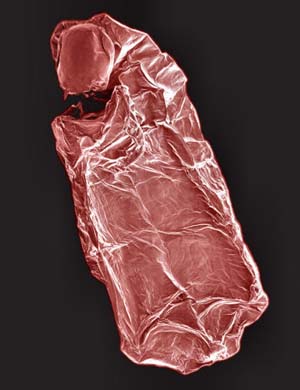Survival tactics of a species of African fly larvae
The larvae of an African fly can survive terrible droughts thanks to its ability to transform into a candy-like form. Scientists can rely on this ability to study ways to preserve blood transfusions or even organs for transplants.
Some molluscs when severely dehydrated enter a state of inactivity when their metabolic processes stop completely. When conditions are right, life will return. The larvae of African flies Polypedilum vanderplanki can live up to 17 years in drought to wait for the next rain by eating crumbs in puddles of rain.
Most animals know how to 'dry themselves' often very small, such as tardigrades. Biologists have long known that a sugar called trehalose plays an essential role in the survival strategies of some of these species. During the drying process, trehalose replaces water in the cell fluid and is thought to be in a near-glass state, like a molten sugar solidifying in candies. Sugar in glass form will keep these cell structures bound together.
This is the process that takes place in the vanderplanki Polypedilum fly."This is the first direct evidence for 'glassy state' in any animal," said Takashi Okuda, a researcher at the National Institute of Agricultural Biology in Tsukuba .

Rolled into a mummy 4mm long, fly larvae can sustain their lives for years, enduring terrible droughts and extreme temperatures.
Okuda and his colleagues collected vanderplanki Polypedilum - which looks more like a mosquito than a fly - in Malawi, Burkina Faso and Nigeria. After many years of effort, the group was able to make this insect reproduce in the laboratory, providing continuous larvae for research.
Infrared imaging of dry larvae shows that trehalose is distributed evenly throughout the body. And when the researchers increased the temperature, they found that the peak of the larvae's heat absorption was about 70 degrees Celsius. This peak is characteristic of the transition when solid lines begin to melt, indicating that The road has reached the glass state.
In another experiment, the scientists discovered signs of trehalose molecules bound to double-layer fat membranes that encapsulate cells. Trehalose has therefore replaced the water to stabilize these membranes. The results of the work appear in the Proceedings of the National Academy of Sciences No. 1 April 1. Jim Clegg, University of California, Davis, affirmed ' This is an important evidence that insects turn to the glassy state. . '
Okuda said he and other scientists wanted to know the secret of P. vanderplanki to apply it to transferring blood to dry form. The main challenge of this is to make trehalose penetrate the membrane of red blood cells and white blood cells. Finally, this technique can be used to preserve complete internal organs.
According to Okuda, one day people can "dry themselves" when they are alive with trehalose - perhaps to live through long journeys to other stars? 'This is a very long step, but in theory, I think it is possible.'
Currently, P. vanderplanki is traveling in space: Okuda and his colleagues sent dried larvae samples to hang outside the International Space Station to consider their diet.
- The 'unimaginable' way of survival of African aborigines
- The amazing survival strategy of beetles lives in one of the driest deserts in the world
- Ladybug larvae use dung as fighting weapons
- Strange but particularly effective hunting tactics in the natural world
- The 'Deep' is amazingly solid
- Rare bat species in Africa
- The human parasite-eating monsters
- The larvae are snuggled into a big tuft for self-defense
- Video: The 'weird' fish with its crystal-clear body
- 10 scary weapons and tactics in ancient war
- Types of insects that have tactics
- Fanciful world ephemeral
 Why do potatoes have eyes?
Why do potatoes have eyes? 'Tragedy' the world's largest carnivorous life: Death becomes ... public toilet
'Tragedy' the world's largest carnivorous life: Death becomes ... public toilet Tomatoes were once considered 'poisonous' for 200 years
Tomatoes were once considered 'poisonous' for 200 years Detecting microscopic parasites on human face
Detecting microscopic parasites on human face Her blood becomes a powder-like powder, which helps preserve and last longer
Her blood becomes a powder-like powder, which helps preserve and last longer  Technology keeps the flavor of frozen vegetables
Technology keeps the flavor of frozen vegetables 